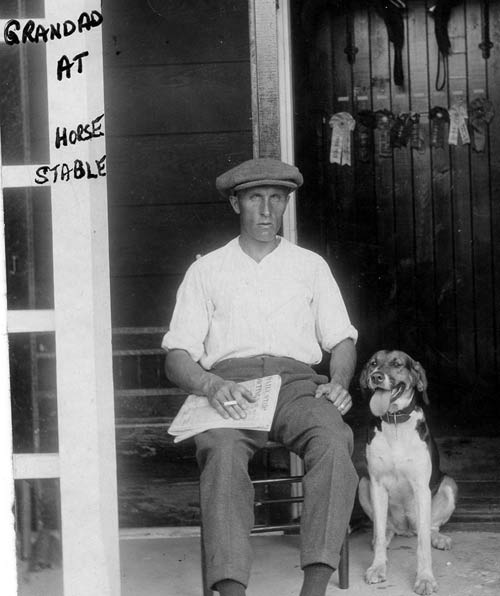 .
.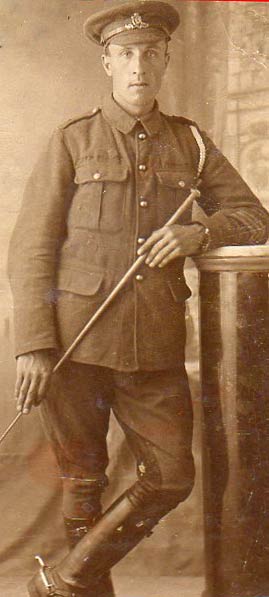 .
.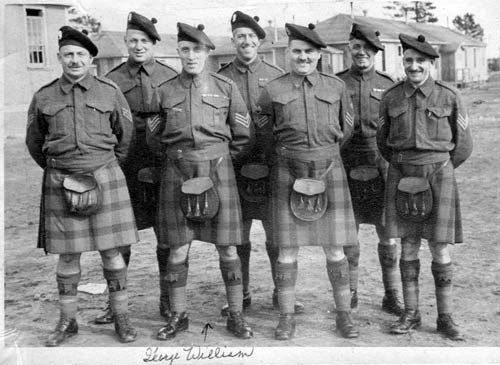
Have proved that there was no relationship between the 2 William George Turners that married Mead sisters.
 .
. .
.
Topp's husband W G Turner in later life in Canada
1887 William George Turner b.6/1/1887, baptised 30/1/1887 in Dublin Mar 1887 North Reg. District Dublin. (details on his father's service record) to parents William Turner & Mary Ann Rigden [a widow, so this not her maiden name].
1891C , he is living at 17 Church Street, Poplar, London with his father, 40, a Foreman of Machinery, his mother and sister Florence. Have proved that William 1848 had been in the militia - this explaining his presence in Dublin ~1887.

1898 cerca. Family moves to the Star Inn Great Dunmow.
.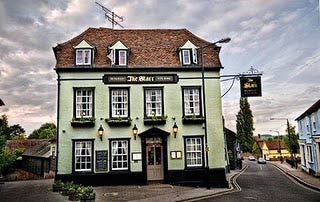 .
.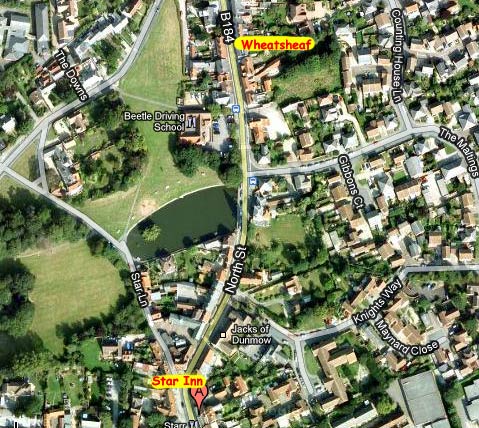
The Star Inn was only a few hundred yards from the Wheatsheaf, the school being in between.
William George Turner & Florence Mead, from the Wheatsheaf, thus lived very near each other, were only one year different in age, and would have attended school together from age ~10-14. I would suspect that they were in love by 1904, when Will almost certainly joined the Royal Horse Artillery, aged 17.
1901C . Living at the Star Inn, Great Dunmow : William Turner 53, publican b.Buntingford, Mary Ann 49 b. Puddleton Dorset, William George Turner 14 b.Dublin, Florence Amelia Turner 12 b.Deptford Kent [?? - conflicts with BMD Mar 1888 Poplar - maybe born Deptford but registered in Poplar? but agrees with 1891C] , Alice Beatrice Turner 9 b. Poplar London Mar 1892..

In a 1902 photo of the Star: "Over the door can be detected the name of the licensee, William Turner. he had taken over from James Jordan & by 1906 had himself been succeded bt Frank Springham" - this found 2011 in a book ' Dunmow in Old picture postcards' by Stan Jarvis in Great Dunmow Library in 2011 - mislaid for the moment!.
1911C. William George Turner, b. Dublin, was Gunner N Battery, Royal Horse Artillery, aged 24, dairyman, in Ambala, India.
Cannot find an army record for him on Findmypast Military records - this suggests, I think, that he was still in the Army when war broke out in 1914. And indeed he was, the Medal Card below being his.
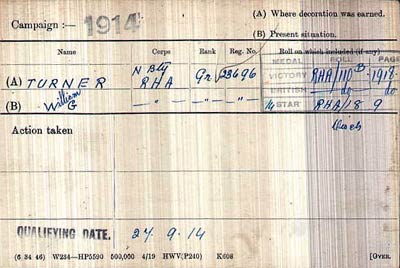
This only tells us that he was discharged. Almost certainly not wounded as he does not seem to have been awarded a Silver War Badge[ would expect this to be mentioned on the above medal card]. Had he joined in January 1904, and, say, he was discharged in Jan 1916, he would have completed a 12 year contract. By Sept 1916 he was working in a Munitions Factory , a dangerous job.
1st Troop Bombay Horse Artillery was formed in Seroor, on the 11th November 1811, as part of the East India Company: when this was dissolved in 1858, the Battery became part of the British Army, undergoing several name changes until it became N Battery Royal Horse Artillery in 1889. On the outbreak of war in 1914, the Battery deployed to France. In 1915 the Battery fired its guns in the Battle of Neuve Chapelle. The Failure of this battle was later credited to the lack of artillery shells in Shell Crisis of 1915, which brought down theLiberal British government of Asquith He formed a new coalition government dominated by Liberals and appointedLloyd George as Minister of Munitions. The Munitions of War Act 1915 prevented recruitment of munitions workers without their employer's consent. It was a recognition that the whole economy would have to be geared for war if the Allies were to prevail on the Western Front. Supplies and factories in Commonwealth countries, particularlyCanada, were reorganised under theImperial Munitions Board, in order to supply adequate shells and othermaterials for the remainder of the war. The Health of Munitions Workers Committee, was set up in 1916 to improve productivity in factories . A huge munitions factory,HM Factory,Gretna was built on the English-Scottish border to produce cordite. An idle part of a factory in Silvertown was pressed into service to manufacture TNT; this exploded in January 1917, killing 73 and injuring 400 in what is known as the Silvertown Explosion.
1916. 25 Sept 1916 ,W G Turner , 29 , shell turner in Munitions Factory, of Ponders End, married Florence H Mead (known in the family as Topp), 27, of Great Dunmow,. Married in Great Dunmow Church by banns. . Parents were Walter Mead[deceased] and William Turner,[ he actually deceased but I did not note this] both licensed victuallers. Witnesses were Louis Einon Jones & Alice Beatrice Turner [his ~24yr old sister] . Have seen original entry in ERO, still in the written register.During World War One, a huge munitions factory, the Ponders End Shell Works was built in Wharf Road. The factory building was sold after the war.
1917. His daughter Dorothy Odette Turner was born in September, at the Wheatsheaf Dunmow. Her b.c. gives him as a "turner", gun ammunition factory & his address as 59 Southfield Road, Ponders End Enfield
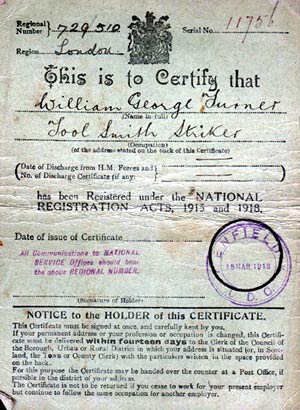
1918.15/3.The address on the back of this was 36 Suffolk Road, Ponders End, Middx. Also OHMS stamped on it . This was also his address on 29/12/1918 when his daughter was baptised in Great Dunmow.
1920. He emigrated to Canada with his wife & daughter. For details of this & his life 1920-1966 see Florence H Mead
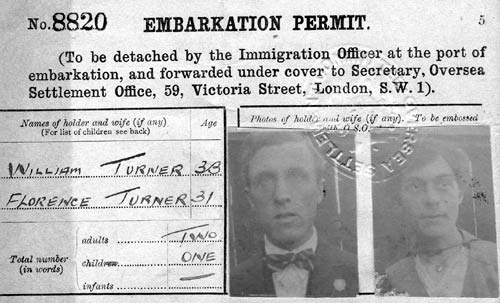
1927?. Son William - Billy- born.
Nancy's Story: that of his granddaughter Nancy Kingdon / Parke, daughter of Dorothy Turner & Ernest Kingdon.
Grandad worked for a well-to-do employer of his and went up to their summer home (very large) in Roches Point on Lake Simcoe every summer. Their names were Mr. and Mrs. Matthews. Grandad was a groom for them and looked after their horses. I do remember my mom telling me a story about one of their horses. They had a little girl who had epilepsy. And one day she had a seizure out in the field. Apparently this horse stood over her until the seizure subsided to protect her. My mom named me after this little girl
My grandad was a tough but I loved him old fellow. I remember him coming home after the war and we were all excited to see him . As a matter of fact that's the first time I remember ever seeing him. He was a heavy smoker and a good drinker. We went over to their apartment on Saturday evenings and played cards (specifically "help they neighbour"). Have you ever heard of that game? Grandad loved to eat snails and yucky stuff. We had a lot of fun with them. Once though, mom, dad, my brother, my grandma and myself went up to the cottage for the weekend. Grandad didn't want to go. However, when we came home and drove in the alley behind our apartments we could see smoke billoughing from grandma's porch. HE must have tried to cook something and it started smoking. He leaned over the railing ranting and raving at grandma. He blamed her for the fire. He could be quite crusty at times and I often wondered if grandma's friend "Jack Cutler" was more of a friend that she let on. She was with him a lot.
I really don't know what grandad did in the army in WW2 and I don't know where he had come from when he came home. He did bring us all little gifts as if he had been somewhere else (maybe India). He also had his uniform on at the time and he had a dufflebag that he reached into to get our gifts. I could have been 3 or 4 years old (1942/3) at the time. As I said before I really do have an exceptional memory but the dates etc. are only a guess. Sorry, I can't remember him mentioning a Lodge but I know he belonged to the True Orange and Blue Lodge. I'll look into the Irish Regiment as best I can. Perhaps my cousin Carl (who probably has his medals) would know more but I don't have his address or email.
. . .The Irish Regiment was sustained in times of peace -1919-1939 - as a Machine Gun Batallion & in 1931 adapted the saffron kilt as a part of its official dress. Several cadet corps were attached to the IR during these years. During the later years of the war ,2nd Batallion was composed of men ineligible for Active Service & trained in a Home Defence role.
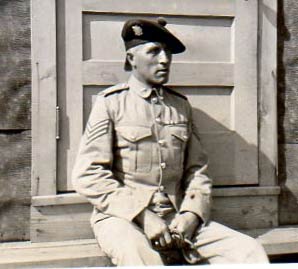 .
.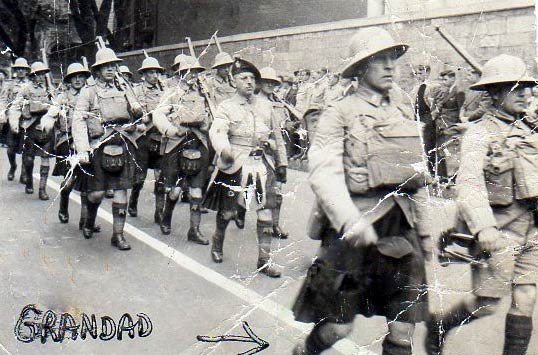 .
.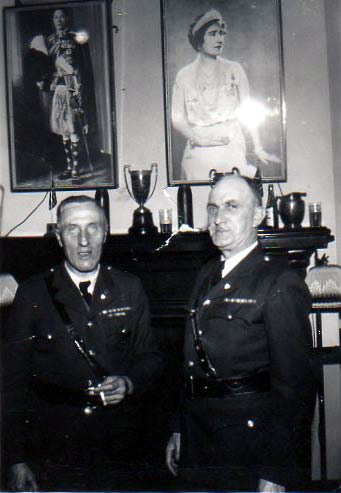 .
.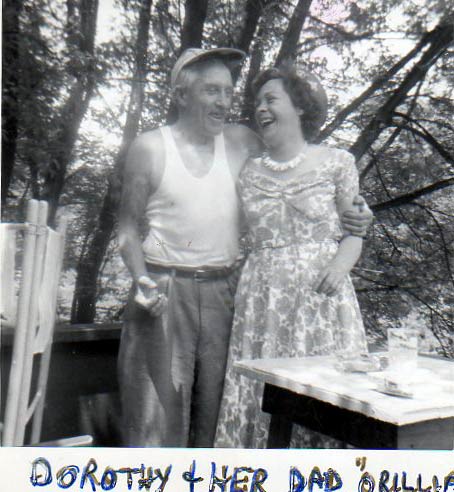
. . . . Seemingly an officer in the Irish Regiment
~1949. He suffered from lung cancer & had part of a lung removed .But he continued to smoke and drink.
~1957.He & Topp left Toronto and went to live at Orillia , top of Lake Simcoe, over 100 miles away. They rented a house from their son Billy
1959. His wife, Topp, died in Orillia.
'After grandma died he stayed there only a couple of years then, ~1961?, came back to north end of Toronto living in one room of a house. I lived 2 streets over from him in 1962 in an apartment. He loved his dog Bingo but I really can't remember if the dog died when he came to Toronto or if he sold him.
The cancer came back and that's what killed him'.
1966. William George Turner died 12/3/1966. Both he & Topp are buried out at Orillia. Grave?